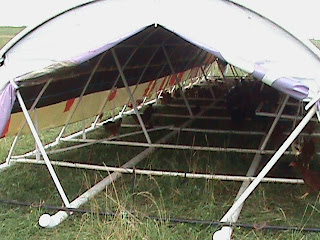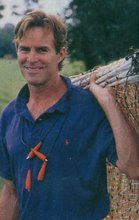An Update on the Prairie Schooner Pastured Layer Production Model
Enough water has gone under the bridge to give an assessment and update on our prairie schooner production model at Grazeland Farms. We have begun a website for the operation,
www.grazelandfarms.com, and you can see some more photos there; future schooner blogs may be posted there as well.
Mike Comish, my business associate and optimist extraordinaire informed me on a blustery day in January that 3000 Layer pullets had been ordered to come beginning February 13, 1000 at a time in three consecutive weeks. I totally freaked out.
"Mike!" (dramatic pause) "We don't have a brooder yet!" Wild look. "We've got to pour cement and build a shop! It's January!! Sputter, sputter, sputter..." my lips were moving and incoherent sounds gurgled out in vain as he smiled back calmly.
"Yeah, I know, I know." (trademark Mike chuckle/giggle) "But I think the guys need a little pressure to pick up the pace."
I got enough 'little pressure' from that exchange to rupture my gizzard.
But Mike held his ground, the chicks came, the shop wasn't completed until we had over 5000 chicks and we've been chasing our rear ends with both hands ever since.
We have finally dug out enough to catch our breath and feel pretty good about where we've come. Thus the (late) blog entry.
I'll get right to the schooners. They are proving out very well. We've made the following modifications from my previous posting.
Modifications
1. Billboard tarps are much cheaper than new tarp. Our tarp costs $500. The PVC and other materials I don't have broken out yet. Stay tuned. The billboard tarps are 14 x 48'. We put the advertisement on the inside and a Roman numeral on the outside.
2. End caps are sewn in permanently with zippered doors and tie down straps. No velcro, no running for them when it's already raining and blowing.
3. Side flaps are sewn in. Ditto above. They have a re-bar running the 48' length in a sleeve and they have an "S" bend in the ends to make the cheapest hand crank on earth. With four or five turns one person can roll the entire flap up or down in as many seconds. Slick, huh?
4. We've cut the number of cross joints on the floor in half.
5. Metal pipe draw bars on each end with welded on re-bar loops to hook chain on to allow us to pull the schooner from either direction.
 Schooner in the foreground, another wagon train of schooners in the back right, cattle shade sleds in the left
Schooner in the foreground, another wagon train of schooners in the back right, cattle shade sleds in the left
Schooner pared down interior showing perches on right, draw bar front, no nest boxes yet
The schooners have weathered high winds, snows, rains and quite a few tractor- and horse-drawn moves. We haven't mashed a single bird that I know of - an incredible record compared with my experience with hand-pulled pens. (But, in fairness those were all with sluggish broilers. However, in our first moving schooner test batch in the fall of 2007, as I noted in an earlier post, we didn't mash a single broiler either.)
Challenges
Challenging us most has been fencing - we are hoping to go to guard dogs and quit using so much costly and time-consuming electronet.
Flock integrity has been a problem. We saw our 500-bird schooners as a way to compare rations, hatcheries and other variables. The birds had other ideas. Like walking through and flying over the electronet to get to the schooner being fed first. Or just for fun, I don't know.
Water is now under control. It is delivered via hydrants and inexpensive air hose to nipple drinkers running the entire schooner length. These come in sections compressed together; joints held together with an O-ring. When birds roost on them the joints pull apart and water flows everywhere. Our current solution - probably too extravagant - is a protective perch above the drinkers. It raises to make room when we will eventually need to catch chickens.
Predators are a constant challenge and not the topic of this post, but the reason we are seeking guard dogs.
Nest boxes were perplexing until Mike noticed a pile of eggs laid by our eggmobile hens in an errant 5-gallon plastic bucket. We're now buying stock in the 5-gallon bucket business. We pop rivet them together at an angle equal to the purchased nest boxes (whatever that is) and use an industry "nest insert" ($5), also riveted, and cover the nest trays with a home-made 1/4" x 3" plastic strip cover. So far, so good. Again, stay tuned. These come in well under $10 a nest and we're halving the industry-recommended 1 nest to 5 birds to Salatin-recommended 1 to 10 to cheapen that further.
BIG machine
We spent $50,000 on an egg candling, washing, grading, sorting machine. It will handle 7000 eggs per hour. That I'd like to see. By this time next month enough of the Feb. babies will be producing eggs that we will start revving it up. Since we aspire to 500 dozen per day this year, we need such a machine and we bought one that we can grow with.
All this to report that, so far, the schooners have been the least of our problems. I'm working on getting materials and costs together and plan to offer the tarp and instructions/materials kit on this website with our processing equipment.
Soon up in our products page will be our latest new item, a 3 gallon PVC feeder for $40. This will replace an outsourced feeder that is imported and pricier. Again, please stay tuned.
Better yet, drop a note if this kit is of interest to you. It might "giddy us up" a little bit.
I'll get into the nest boxes and other specifics in a future post. Happy grazing!
P.S. Thanks and congrats to the Polyface gang for another amazing field day last Saturday and special thanks for including Featherman Equipment among the select vendors group.

